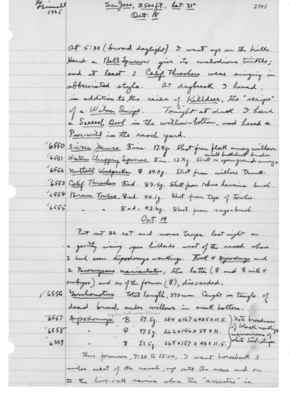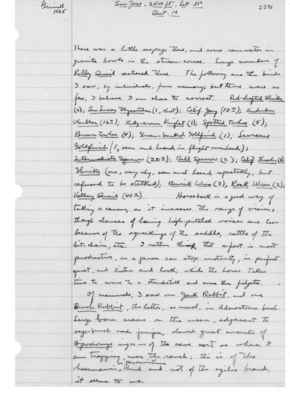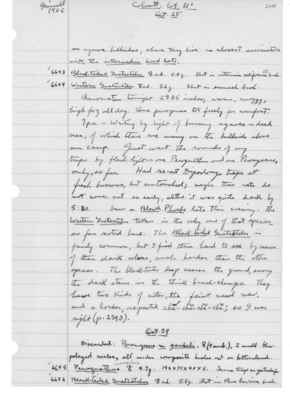Pages That Mention Dipodomys
1925: Joseph Grinnell's field notes
S3 Page 52
Collector: Grinnell - 1925 Location: San Jose, 2500 ft., lat. 31 degrees Date: October 18, 1925 Page Number: 2595
at 5:30 (broad daylight) I went up on the hills. Heard a Bell Sparrow give its melodious tinkle; and at least 3 Calif. Thrashers were singing in abbreviated style. At daybreak I heard, in addition to the cries of Killdeer, the “scaipe” of a Wilson Snipe. Tonight at dusk I heard a Screech Owl in the willow-bottom, and heard a Poor-will in the ranch yard.
6550 Sierra Junco (male sign) im. 12.4g. Shot from flock among willows. 6551 Western Chipping Sparrow (male sign) im. 12.4.g. Shot in open ground among small buckwheat bushes. 6552 Nuttall Woodpecker (female sign) 34.0g. Shot from willow trunk. 6553 Calif. Thrasher (male sign) ad. 83.5.g. Shot from rhus laurina bush. 6554 Brown Towhee (female sign) ad. 40.1g. Shot from top of towhee. 6555 “ “ (male sign) ad. 43.6g. Shot from sage-bush.
Oct 19 Put out 22 rat and mouse traps last night on a gently rising open hillside west of the ranch where I had seen dipodomys workings. Took 4 Dipodomys and 2 Periomyscus maniculatus; the latter ((male sign) and (female sign) with 4 embryos) and one of the former ((male sign)), discarded.
6556 Gerrhonotus Total length, 370 mm. Caught in tangle of dead brush under willows in creek bottom. 6557 Dipodomys (male sign) 59.5g. 284 x 167 x 40.5 x 11.5. } Note broadness 6558 “ “ (female sign) 47.5g. 262 x 156 x 39 x 11. } of black markings, narrowness of 6559 “ “ (male sign) 51.5g. 265 x 157 x 40 x 11.5. } white tail-stripe. This forenoon, 7:30 to 12:00, I went horseback 3 miles west of the ranch, up onto the mesa and on to the live-oak ravine where the “arrastre” is.
S3 Page 53
Collector: Grinnell - 1925 Location: San Jose, 2500 ft., Lat. 31 degrees Date: October 19, 1925 Page Number: 2596
There was a little seepage there, and some rainwater in granite bowls in the stream-course. Large numbers of Valley Quail centered there. The following are the birds I saw, by individuals, from memory; but there were so few, I believe I am close & correct. Red-shafted Flicker (2); San Lucas Flycatcher (1, shot); Calif Jay (10±) Audubon Warbler (16±); Ruby-crown Kinglet (1); Spotted Towhee (5); Brown Towhee (4); Green-backed Goldfinch (1); Lawrence Goldfinch (1, seen and heard in flight overhead); Intermediate Sparrow (20±); Bell Sparrow (2); Calif. Thrashers (3); Shrike (one, very shy, seen and heard repeatedly, but refused to be stalked); Bewick Wren (3); Rock Wren (2); Valley Quail (40±). Horseback is a good way of taking a census, as it increases the range of vision, though chances of hearing high-pitched voices are less because of the squeakings of the saddle, rattle of the bit-chain, etc. I rather think that a foot in most productive, as a person can stop instantly, in perfect quiet, and listen and look; while the horse takes time to come to a standstill and even then fidgets. Of mammals, I saw one Jack Rabbit, and one Bush Rabbit, the latter, as usual in Adenostoma bush. Large bare areas in the mesa, adjacent to sage-bush and juniper, showed great amounts of Dipodomys sign — of the same sort as where I am trapping, near the ranch; this is of the heermanni or paramintinus kind and not of the agilis brand, it seems to me.
S3 Page 67
Collector: Grinnell - 1925 Location: Colnett, Sat. 31 degrees Date: October 28, 1925 ?Page Number: 2609
on agave hillsides, where they live in closest association with the intermedia wood rats.
6643 Black-Tailed Gnatcatcher (female sign) ad. 5.8g. Shot in artemesia californica (?) bush. 6644 Western Gnatcatcher (male sign) ad. 5.6g. Shot in sumach bush.
Barometer tonight 29.85 inches; warm, muggy; high fog all day. One perspires too freely for comfort. 7 p.m. - Writing by light of of burning agaves- dead ones, of which there are many on the hillside above our camp. Just went the rounds of my traps by flash light - one Perognathus and one Peromyscus, only, so far. Had re-set Dipodomys traps at fresh burrows, but untouched; maybe these rats do not come out so early, altho it was quite dark by 5:30. Saw a Black Phoebe late this evening. The Western Gnatcatcher taken is the only one of that species so far noted here. The Black-Tailed Gnatcatcher is fairly common, but I find them hard to see by reason of their dark colors, much harder than the other species. The black-tails keep nearer the ground, among the dark stems in the thick brush-clumps. They have two kinds of notes, the faint nasal mew, and a louder, repeated che-che-che-che; so I was right (p. 2593).
Oct. 29 Discarded: Peromyscus m. gambeli, (female sign) (4 emb.), 2 small blue pelaged males, all under composite bushes out on bottomland. 6645 Perognathus arenarius (male symbol) 9.7g. 142 x 71 x 20 x 5. Same trap as yesterday’s. 6646 Black-Tailed Gnatcatcher (male symbol) 5.8g. Shot in Rhus laurina bush.
S3 Page 68
Collector: Grinnell - 1925 Location: Colnett, Sat. 31 degrees Date: October 29, 1925 Page Number: 2610
6647 Dipodomys (male sign) 60.3g. 250 x 141 x 42 x 9. On silt-soil bottom. 6648 Thomomys (female sign) 96g. 207 x 70 x 26 x 4. “ “ “ 6649 Bewick Wren (female sign) ad. 9.9g. Shot from black-sage bush. 6650 Brown Towhee (male sign) ad. 44.5g “ “ lycium bush. 6651 “ “ (female sign) ad. 41.6g. Shot in flight among agaves. 6652 Horned Owl (female sign) bill, skull and a mass of feathers of Mudhen in stomach; flushed from willows out in valley where, at freshet time, the San Rafael River flows; now only sand there; but tidal seepage lagoons below, toward beach.
Drizzled during the night and this morning, but cleared up about 10 o’clock and now (2 p.m.) warm and sunshiny. Out early and then 7:30 to 9:30. Saw numerous Audubon Warblers around sumachs (R. laurina). Noted one Sparrow Hawk up on hillside among agave stems. These (old stalks) afford roosting places for many birds: Shrikes Ravens, Linnets, and today I saw an adult Red-Tailed Hawk perched on one. The new flower stalks are just shooting up, but not out yet. Saw a very white Marsh Hawk (probably same one) several times skimming above the bush tops on the bottomland. The coastal part of our “section” presents seeming contradictions: the air is humid a large part of the time, yet the vegetation is xerophilous in the extreme. The actual rainfall must be little, and there must be streaks of excessively dry weather. Here are eight species of cactus, the agave, 3 species of lycium,



